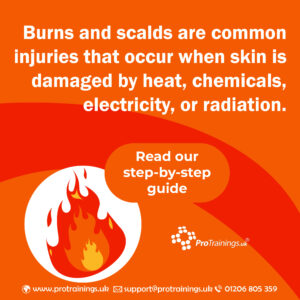Burns and Scalds: How to Treat and Manage Burn Injuries
Burns and scalds are common injuries that occur when skin is damaged by heat, chemicals, electricity, or radiation. They can range from mild to life-threatening, depending on the depth and extent of the burn. Knowing how to treat burns and scalds promptly and effectively can reduce pain, prevent infection, and minimise long-term damage.
Understanding Burns and Scalds
- Burns: These are caused by dry heat sources, such as flames, hot surfaces, or electrical contact.
- Scalds: These result from wet heat, such as hot liquids or steam.
Burns and scalds are classified into three categories based on severity:
- Superficial Burns (First-degree burns):
- Affects only the outer layer of skin (epidermis).
- The skin is red, dry, and painful but not blistered.
- Often caused by brief contact with hot surfaces or mild sunburn.
- Partial-thickness Burns (Second-degree burns):
- Affects the epidermis and the underlying layer of skin (dermis).
- The skin is red, blistered, and may be swollen and painful.
- Caused by longer exposure to hot objects or severe sunburn.
- Full-thickness Burns (Third-degree burns):
- Affects all layers of the skin and can reach the tissues beneath.
- The skin may look charred, black, or white and leathery.
- These burns are often painless due to nerve damage but are extremely serious and require immediate medical attention.
Immediate First Aid for Burns and Scalds
- Cool the Burn:
- Run the affected area under cool running water for at least 20 minutes. Do this as quickly as possible after the injury to stop the burn from spreading and to reduce pain.
- Remove Clothing and Jewellery:
- Carefully remove any clothing or jewellery near the burn unless it is stuck to the skin. This helps to prevent further heat damage and reduces the risk of swelling cutting off circulation.
- Do not attempt to remove anything that is stuck to the burn, as this can worsen the injury.
- Protect the Burn:
- Once the burn has been cooled, cover it with a clean, non-fluffy material, such as cling film. This helps to protect the area from infection and keeps the burn clean.
- Do not apply creams, lotions, oils, or butter to the burn, as these can trap heat in the skin and may lead to infection.
- Keep the Casualty Warm:
- Use a blanket or clothing to keep the casualty warm, but avoid putting pressure on the burned area. This is important to prevent hypothermia, especially in cases of large burns, as the body loses heat quickly through damaged skin.
- Seek Medical Attention:
- Burns that cover a large area, larger than the size of the patients hand, are deep, or are on sensitive areas like the face, hands, feet, or genitals require immediate medical attention.
- For full-thickness burns or burns caused by chemicals, electricity, or radiation, dial 999 for emergency services.
Do’s and Don’ts for Treating Burns
Do:
- Cool the burn as quickly as possible to prevent further damage.
- Use cool running water for 20 minutes to alleviate pain and reduce the severity of the burn.
- Cover the burn loosely with cling film to prevent infection.
- Seek medical attention for severe burns, electrical burns, chemical burns, or if the burn affects a large area (larger than the patients hand) or a child or elderly person.
Don’t:
- Do not use ice or iced water, as this can damage the tissue and cause frostbite.
- Do not apply creams, oils, or butter to the burn, as they can trap heat in and lead to infection.
- Do not break any blisters that form, as this can increase the risk of infection.
- Do not remove clothing stuck to a burn, as this can worsen the injury.
Special Considerations
Electrical Burns:
- Electrical burns may not always appear severe on the surface, but they can cause significant internal damage. If someone suffers an electrical burn, turn off the power source, if it is safe to do so, and seek medical help immediately. Do not touch the person until you are sure the electricity has been turned off.
- Remember to treat both entry & exit point burns
Chemical Burns:
- If the burn was caused by chemicals, refer to the chemical COSHH or SDS for correct treatment, flush the area with cool running water for at least 20 minutes to remove any traces of the substance. If the chemical is in powder form, carefully brush it off before rinsing with water. Avoid touching the chemical ensure appropriate PPE is worn and seek immediate medical help.
Sunburn:
- Sunburn is a type of superficial burn caused by overexposure to the sun’s ultraviolet (UV) rays. Mild sunburn can be treated by cooling the skin with water or applying a moisturising lotion after the initial cool down. Severe sunburn, especially if accompanied by blisters or signs of heatstroke, may require medical attention.
When to Seek Medical Help
- Burns that cover more than 5% of the body. 1% is the size of the patients hand
- Burns on the face, hands, feet, or genitals.
- Deep burns (full-thickness burns) where the skin appears white, charred, or leathery.
- Any burns in children, the elderly, or people with underlying health conditions.
- Burns caused by chemicals, electricity, or radiation.
- Signs of infection, such as increased redness, swelling, pus, or fever.
Key Points to Remember
- Cool the burn with running water for at least 20 minutes.
- Remove clothing and jewellery around the burn, but do not remove anything stuck to the skin.
- Protect the burn with a sterile dressing or clean material.
- Never use ice, creams, or oils on burns.
- Always seek medical attention for severe burns, or if the casualty is a child, elderly person, or if the burn covers a large area.
